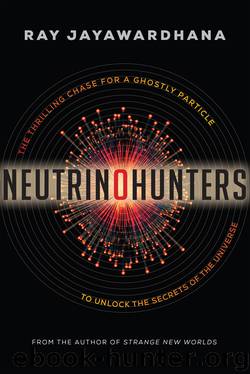Neutrino Hunters by Ray Jayawardhana

Author:Ray Jayawardhana [Jayawardhana, Ray]
Language: eng
Format: epub
ISBN: 9781443414289
Publisher: HarperCollins Canada
Published: 2013-03-14T16:00:00+00:00
Inside the Kamiokande neutrino detector (Institute for Cosmic Ray Research, University of Tokyo)
Then the results came in. To the utter relief of scientists the world over, the neutrino signal stood out clearly in the data, leaving no doubt as to its provenance. It meant that astrophysicists like Bahcall and his colleagues were right about what happens during a supernova explosion. The phototubes at the Kamiokande detector had picked up eleven flashes in a burst lasting several seconds, nearly three hours before the first optical sighting of the supernova by astronomers in Chile and New Zealand. Halfway around the world, not far from Cleveland, a similar neutrino detector located in a shallow salt mine under Lake Erie registered eight flashes at exactly the same time as Kamiokande. Later, scientists learned that a third, oil-based detector located in the Baksan Gorge of the Caucasus Mountains in Russia had also recorded five. The two dozen neutrinos detected by these three experiments were just a few of the billions upon billions of neutrinos sweeping past and through our planet in a burst that originated in the heart of the exploding star in the LMC. Since all three of these neutrino “observatories” are located in the Northern Hemisphere, while the LMC is in the southern sky, the neutrinos had to traverse from one side of the Earth to the other, through our planet’s interior, and enter the detectors from below. Delighted by the experimental confirmation of theoretical predictions, Bahcall told Time magazine that it felt surreal to be part of the scientific commotion surrounding Supernova 1987A.
Detecting a grand total of two dozen particles may not sound like much to crow about. But the significance of these two dozen neutrino events is underlined by the fact that they have been the subject of hundreds of scientific papers over the years. Supernova 1987A was the first time that we had observed neutrinos coming from an astronomical source other than the Sun. So it wasn’t a big surprise that Japanese physicist Masatoshi Koshiba, leader of Kamiokande, won a share of the 2002 Nobel Prize in physics in large part for measuring these neutrinos. The ghostly particles conjured up by Wolfgang Pauli decades earlier to explain beta decay had now become useful cosmic messengers for astronomers in their quest to understand the life cycle of our Sun, as well as those of massive stars.
With these neutrino detections, as Adam Burrows of Princeton University wrote, “for the first time, we have penetrated the otherwise opaque supernova ejectum and glimpsed at the violent convulsions that attend stellar collapse.” The observations confirmed the basic picture theorists had developed over decades of what happens when a massive star runs out of nuclear fuel. As John Beacom, a theoretical physicist at Ohio State University who is interested in the connections between particle physics, astrophysics, and cosmology, reflected, “Neutrinos allow us to see the interior of a massive star at the end of its life, so we can do astrophysics that astronomers could otherwise never do.
Download
This site does not store any files on its server. We only index and link to content provided by other sites. Please contact the content providers to delete copyright contents if any and email us, we'll remove relevant links or contents immediately.
| Aeronautics & Astronautics | Astronomy |
| Astrophysics & Space Science | Comets, Meteors & Asteroids |
| Cosmology | Mars |
| Solar System | Star-Gazing |
| Telescopes | UFOs |
Tools of Titans by Timothy Ferriss(8216)
Turbulence by E. J. Noyes(7935)
Secrets of Antigravity Propulsion: Tesla, UFOs, and Classified Aerospace Technology by Ph.D. Paul A. Laviolette(5309)
Astrophysics for People in a Hurry by Neil DeGrasse Tyson(5130)
Room 212 by Kate Stewart(5035)
Design of Trajectory Optimization Approach for Space Maneuver Vehicle Skip Entry Problems by Runqi Chai & Al Savvaris & Antonios Tsourdos & Senchun Chai(5011)
Pale Blue Dot by Carl Sagan(4909)
The David Icke Guide to the Global Conspiracy (and how to end it) by David Icke(4624)
A Journey Through Divination and Astronomy by Publishing Pottermore(4344)
Goodbye Paradise(3726)
Apollo 8 by Jeffrey Kluger(3636)
COSMOS by Carl Sagan(3554)
Losing the Nobel Prize by Brian Keating(3498)
The Five People You Meet in Heaven by Mitch Albom(3474)
How to Read Water: Clues and Patterns from Puddles to the Sea (Natural Navigation) by Tristan Gooley(3406)
Brief Answers to the Big Questions by Stephen Hawking(3369)
How to Read Nature by Tristan Gooley(3249)
The Order of Time by Carlo Rovelli(3145)
A Brief History of Time by Stephen Hawking(2960)
